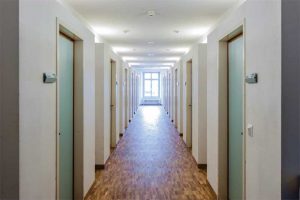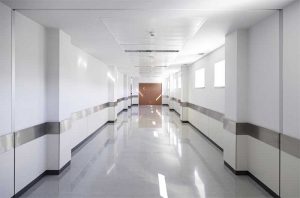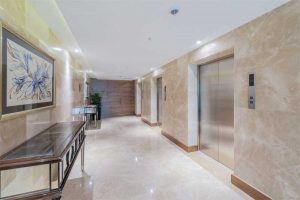Smoke doors versus fire doors: What is the difference?
by sadia_badhon | June 13, 2019 10:00 am
by Lori Greene, AHC/CDC, CCPR, FDAI, FDHI
 [1]
[1]Architects often use the phrase ‘20-minute smoke door,’ and it is common to see a door schedule calling for these products. To properly specify doors, frames, and hardware for fire door and smoke door assemblies, it is critical the proper terminology is used and the correct code requirements are referenced. Fire doors, even the 20-minute assemblies, are subject to completely different criteria than the non-fire-rated smoke doors.
For example, for a 20-minute fire door on an architect’s door schedule, the hardware specifier will designate a labeled door and frame, positive-latching hardware, a door closer or automatic-closing device, and gasketing. All of the hardware will have to be listed or labeled for use on a fire door assembly, and any glazing in the door or sidelight would be subject to the limitations of the manufacturer’s listings.
If this door is in a hospital corridor smoke partition and leads to a patient room, and the building is protected throughout by an automatic sprinkler system, the current model codes do not require a 20-minute fire door assembly. The door, frame, and hardware do not have to be listed or labeled for use as components of a fire door assembly. Additionally, the door is not required to be self- or automatic-closing. Vision panels are not limited in size and need not have fire-protection-rated glazing.
 [2]
[2]The International Building Code (IBC) and National Fire Protection Association (NFPA) 101, Life Safety Code, do mandate positive-latching hardware for these doors in hospital corridors. Further, the clearance around the door must be limited, but other requirements associated with 20-minute doors do not apply. Specifying 20-minute assemblies where they are not mandated by code would result in added expense and could also affect the functionality of the opening. For example, a 20-minute fire door would require a door closer, an inconvenience for patients and staff. The alternative, an automatic-closing device that holds the door open and closes the door on actuation of the fire alarm system, would be very expensive, especially when multiplied by the total number of patient rooms.
Fire doors
In the United States, common ratings of fire door assemblies are three hours, 90, 60, 45, or 20 minutes. These opening protectives are typically installed in walls that also bear a fire rating, equal to or greater than the category of the fire door assembly. Together, the walls and opening protectives are designed to deter the spread of smoke, flames, and toxic gases during a fire event for the specified amount of time. Fire door assemblies are also required to meet the requirements of NFPA 80, Standard for Fire Doors and Other Opening Protectives.
In most cases, the hardware requirements for swinging fire door assemblies are the same regardless of the rating of the assembly. For example (with a few exceptions), fire doors must have positive-latching hardware, as well as closing devices ensuring the doors are closed and latched during a fire event. Generally, smoke doors without a fire rating do not have the same hardware requirements. Specifying a ‘20-minute smoke door’ can cause confusion, and scheduling a 20-minute fire door where only a smoke door is needed will likely result in hardware that is not required for that location.
IBC mandates fire door assemblies that have a 20-minute rating in three locations:
- corridor walls required to be fire partitions with a one-hour or one-half-hour rating;
- fire partitions with a one-half-hour rating; and
- smoke barriers with a one-hour rating.
When the one-hour smoke barrier is in a health care facility, IBC and NFPA 101 include an exception for double-egress pairs.
 [3]
[3]A common question is why the rating of the fire door assembly (e.g. 20 minutes) is less than the rating of the wall (e.g. half-an-hour or one hour). For most applications, the fire door assembly is tested for a shorter period than the wall because of the increased fuel load likely to be present adjacent to the wall. A swinging fire door would be unaffected by furniture or stored items that might impact the wall’s performance. If a fire door is no longer in use and it is not required for egress, NFPA 80-2016 requires the opening to be filled to maintain the rating of the wall assembly.
Although smoke control is the main concern in locations where 20-minute assemblies are required, 20-minute doors are classified as fire doors, not smoke doors. Fire-protection-rated assemblies are tested to Underwriters Laboratories (UL) 10C, Standard for Positive Pressure Fire Tests of Door Assemblies, or NFPA 252, Standard Methods of Fire Tests of Door Assemblies. Fire-resistance-rated assemblies are tested to ASTM E119, Standard Test Methods for Fire Tests of Building Construction and Materials, or UL 263, Standard for Fire Tests of Building Construction and Materials. Smoke doors are not tested to these standards.
Smoke infiltration
UL 1784, Standard for Air Leakage Tests of Door Assemblies and Other Opening Protectives, applies to some fire doors and smoke doors. For example, when a fire door assembly serves as a smoke and draft control assembly, IBC requires the assembly to be tested in accordance with UL 1784. During this test, “the air leakage rate of the door assembly shall not exceed 3.0 cubic feet per minute per square foot [0.015424 m3/(s • m2)] of door opening at 0.10 inch (24.9 Pa) of water for both the ambient temperature test and the elevated temperature exposure test.”
Where air infiltration is limited to this level, it is difficult or nearly impossible to achieve these values without gasketing at the head, jambs, and meeting stiles. In most locations, a door bottom or sweep is unnecessary to limit the air leakage to the level stated in the model codes. During the UL 1784 test, the area that is at the bottom 152 mm (6 in.) of the door assembly is covered to isolate the measurement of air leakage at the head and jambs, as the leakage at the bottom of the door is of less concern. Where the code specifically states the door assembly must be tested without the bottom sealed during the test, a door bottom or sweep must be used both during the test and on the final assembly installed in the field.
If a fire door or smoke door assembly is required to limit the air leakage when tested to UL 1784, the gasketing products must be listed for this purpose and will be indicated as such in the manufacturer’s catalogs. These doors will typically have an ‘S Label,’ which says the assembly meets the requirement when classified gasketing is installed. In addition to the model codes, the requirement for testing in accordance with UL 1784 (and the same allowable maximum)
is included in NFPA 105, Standard for Smoke Door Assemblies and Other Opening Protectives, which make it applicable to doors that are required to comply with this standard.
Smoke doors
The main source of confusion regarding smoke doors is there are multiple locations where these doors are mandated by model codes, and the requirements may vary depending on whether the assembly is installed in a smoke partition, a smoke barrier, or a wall that is required to limit the transfer of smoke. Smoke doors may be required to comply with NFPA 105, but only where this is mandated by the applicable model code. Here are some examples from IBC.
Doors in smoke partitions
IBC prohibits louvers in doors installed in smoke partitions and requires installation to be in accordance with NFPA 105. However, the rest of the requirements for doors in smoke partitions are dependent on what is mandated by other sections of the code. For example, some sections may require doors in smoke partitions to be self- or automatic-closing by smoke detection, or to have limited air leakage when tested to UL 1784.
Each section requiring smoke partitions (e.g. care suite separations, elevator lobbies) must be referenced to determine the smoke door assembly requirements. Elevator lobby doors in smoke partitions are required to be self- or automatic-closing, but doors in care suite separations in Group I-2 such as hospitals and nursing homes are not. Unlike elevator lobby doors, smoke doors in care suite separations do not require gasketing. Both of these locations require positive-latching hardware. There are also prescriptive requirements in IBC regarding atrium doors in smoke partitions. It is critical to check the code section applicable to the doors in question.
Doors in smoke barriers
In underground buildings and in Use Group I-3 (e.g. detention/correctional centers), IBC requires doors in smoke barriers to be fire door assemblies that meet the requirements of NFPA 80. However, both the IBC and NFPA 101 include exceptions for smoke barrier doors in health care facilities (e.g. IBC: Group I-1, Condition 2, Group I-2, and ambulatory care facilities).
 [4]
[4]In these health care occupancies, double-egress door pairs that are installed in cross-corridor smoke barriers are not required to be fire door assemblies, and positive-latching door hardware is not mandated by the model codes. In Group I-1, Condition 2, the doors assemblies may be either self- or automatic-closing. Past editions of IBC have required Group I-2 and ambulatory care facilities to have doors that are automatic-closing by smoke detection, but the 2018 edition has changed this section slightly. It appears self-closing doors would also be allowed where this edition of the IBC has been adopted.
Non-fire-rated doors in smoke barriers are not required to have limited air infiltration per UL 1784, but these doors must have astragals or rabbets at the meeting edges, and be close-fitting within operational tolerances. The maximum allowable undercut is 19 mm (¾ in.), and the doors must not have louvers or grilles. Frame stops are required at the head and jambs, and vision panels must be fire-protection-rated.
Doors required to provide an effective barrier to limit the transfer of smoke
These doors are typically smoke partition corridor doors in IBC Use Group I-2 (foster care facilities, detoxification centers, hospitals, nursing homes, and psychiatric hospitals), or in NFPA 101 health care occupancies. This could include patient and exam rooms, and other spaces that are not part of a vertical opening/exit (stair or shaft), and where doors do not lead to incidental use areas that requiring a fire rating. As mentioned in the example at the beginning of this article, for non-fire-rated corridor doors in these health care facilities, IBC and NFPA 101 do not require door closers or gasketing, but mandate positive-latching hardware.
Inspections
Both NFPA 80 and NFPA 105 include detailed requirements for inspections of fire door and smoke door assemblies. Since the 2009 editions of the model codes, the inspection requirements have been adopted by reference to these standards. Beginning with the 2007 edition of NFPA 80, fire door assemblies are required to be inspected at least annually, but the 2013 editions of NFPA 80 and 105 mandate additional inspections of fire door and smoke door assemblies after installation and maintenance work.
These inspections help ensure the doors, frames, and hardware are installed correctly and maintained properly so they function as designed and tested throughout the life of the building. The initial post-installation check should be included in the project specification in order to avoid delays during the final occupancy inspections. It is pertinent to note, the inspection requirements do not apply to doors not required to comply with NFPA 80 or NFPA 105, such as patient-room doors in a health care corridor smoke partitions.
Conclusion
When determining the requirements for door assemblies offering protection against the spread of fire or smoke, the first step is to know whether the assembly is required to be a fire door assembly complying with NFPA 80 or a smoke door in compliance with NFPA 105, or an assembly required to meet specific requirements mentioned in model codes. This will establish the requirements for labels, positive latching, self- or automatic-closing devices, glazing, and periodic inspections. If the opening is required to have limited airflow when tested to UL 1784, this will dictate whether gasketing is needed. When in doubt, it is important to contact a local architectural openings consultant, or the authority having jurisdiction (AHJ) for help.
- [Image]: https://www.constructionspecifier.com/wp-content/uploads/2019/06/Hospital-Corridor.jpg
- [Image]: https://www.constructionspecifier.com/wp-content/uploads/2019/06/Residential-Corridor.jpg
- [Image]: https://www.constructionspecifier.com/wp-content/uploads/2019/06/Cross-Corridor-Pair.jpg
- [Image]: https://www.constructionspecifier.com/wp-content/uploads/2019/06/Elevator-Lobby.jpg
- lori.greene@allegion.com: mailto:lori.greene@allegion.com
Source URL: https://www.constructionspecifier.com/smoke-doors-versus-fire-doors-what-is-the-difference/